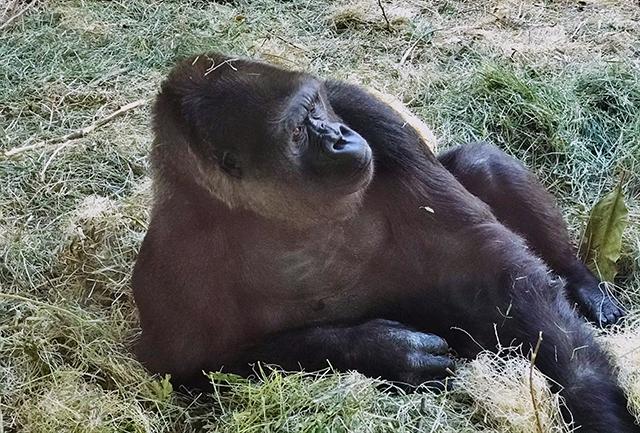
Six ape genomes sequenced telomere-to-telomere
A definitive reference has become openly available for comparative evolutionary studies of humans and the apes closest to us on the tree of life.Media Contact: Leila Gray - 206-475-9809, leilag@uw.edu
Comprehensive reference genomes have now been assembled for six ape species: siamang (a Southeast Asian gibbon), Sumatran orangutan, Bornean orangutan, gorilla, bonobo and chimpanzee. Areas of their genomes previously inaccessible because of structural complexity have now mostly been resolved.
The resource is already lending itself to comparative studies that offer new insights into human and ape evolution, and into what underlies the functional differences among these species.
A report on how the telomere-to-telomere ape genome references were developed, and what scientists are learning from it, appears in the April 9 edition of Nature. Telomere refers to the cap found at the two opposite ends of a chromosome.
The senior researchers and corresponding authors on this international, multi-institutional project were Evan E. Eichler, professor of genome sciences at the University of Washington School of Medicine and an investigator of the Howard Hughes Medical Institute; Kateryna D. Makova of the Department of Biology, Penn State University; Adam M. Phillippy of the National Human Genome Institute at the National Institutes of Health. The lead author is DongAhn Yoo, a postdoctoral fellow in the Eichler lab.
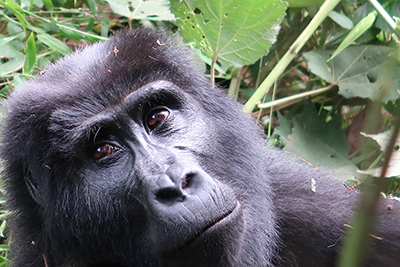
“These ape genomes will enable us to reconstruct the evolutionary history of every base pair in our genome,” Eichler said.
He described the project as a massive team effort with over 40 research labs and over 120 scientists from around the world working years to assemble, quality control, and analyze these genomes.
The scientists on this project estimate that each of the recent genome assemblies is more than 99% resolved, including the most difficult bits.
These polished versions have significantly improved the sequencing accuracy of previous ape genome assemblies and are comparable to the quality of the most recent human genome references. This eliminates some of the biases from previous comparisons in which the human genome assemblies were always superior.
The researchers also constructed a 10-way pangenome – a method to organize a group of genome assemblies – to compare all six ape genomes plus four human genomes. It is accompanied by an interspecies graph.
The latest findings, for instance, reveal some genetic distinctions among humans and apes in such areas as the immune system, longevity and brain development. This knowledge may have biomedical relevance in fields like aging, speech acquisition, neuropsychiatry and immunology.
Human-like apes split off from chimps about 5.5 to 6.3 million years ago. Chimps, along with bonobos, are our nearest living primate relatives. It is widely reported that chimps and humans share 99% of their genomes, but in-depth comparisons point to subtle nuances. These might help explain why chimps and humans aren’t more alike. The genomes of the two species don’t quite align, particularly in certain regions
African apes, our next closest kin on the primate ancestral tree, diverged about 10.6 to 10.9 million years ago, and orangutans some 18.2 to 19.6 million years ago.
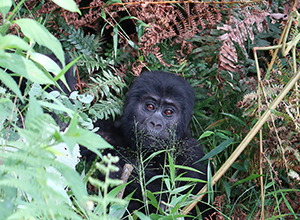
The new ape genome resource is proving useful in analyzing the mechanisms involved in ape speciation – how new species evolve from existing ones – and calls into question prevailing views about how various ape species came into being.
Other explorations of the ape reference genomes have led to unexpected findings of potential therapeutic significance. For example, the evolution of much smaller but fully functional centromeres (involved in controlling cell division) in bonobos may offer ideas for engineering streamlined artificial chromosomes to transmit genetic information into human cells to treat or prevent disease.
In additional analyses of the ape genomes, scientists systematically worked to pinpoint the most rapidly evolving regions in each primate species. These are areas with an accelerated rate of mutations often associated with the emergence of new genes that are specific to one species.
One of the most structurally diverse, gene-rich regions is the major histocompatibility complex. This is the name for a huge cluster of genes that code for the cell-surface proteins that enable the body’s immune system to distinguish between its harmless self and potentially harmful intruders.
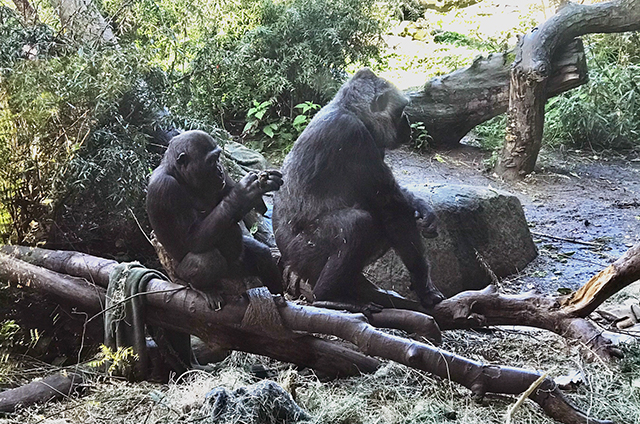
This region varies greatly among mammals. When compared with the human genome, this region shows that ancient, species-specific differences may be key to understanding a number of diseases that affect only people.
In examining great ape genetic diversity, the researchers looked for genomic signatures that suggested adaptation. Besides enrichment in areas implicated in immune function and in the formation of the outer skin, there are pathways associated with brain development and diet. These include sensory perception for tasting bitterness, the breaking down of lipids like fats and oils, and the movement of iron within the body.
Assessments of what evolutionary genome scientists call “Ancestor Quickly Evolving Regions” found that there were more than double the number of previously discovered regions of this type in humans. Usually, but not always, these areas are characterized by highly repetitive DNA.
One example of such an area is a gene associated with a brain cell in an area of the brain’s motor cortex that is linked to talking.
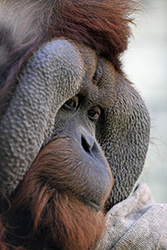
This gene is analogous to one that plays a role in vocal learning centers in songbirds and governs song production. Humans have a unique genetic control element in the middle of this Human Ancestor Quickly Evolving Region.
Of special interest to human and ape evolutionary studies are repeats in the DNA code called segmental duplications. Earlier genome sequencing studies failed to completely characterize these regions. Technical advances in long-read sequencing made these regions accessible for the first time.
Segmental duplications are one of the ways that gene innovations originate. They appear to play a major role in genetic variation among apes, including dramatic restructuring of large portions of the chromosomes.
Segmental duplications are enriched in the short arms of certain types of chromosomes that are joined, not in the middle, but off-center so that their arms are of different lengths. Examples of these so-called acrocentric chromosomes are chromosomes 13, 14, 15, 21 and 22.
Acrocentric chromosomes are unusual in other ways that contribute to differences among ape species. Compared with other chromosomes, there are excessive repeating sequences and recombinations on the short arms of these acrocentric chromosomes.
Orangutans have more acrocentric chromosomes than other apes, the researchers explained. They also have the greatest number of segmental duplications in comparison to the African great apes. Chimps, bonobos and gorillas, but not siamangs, have more segmental duplications than humans and other primates do.
For the first time, researchers have been able to study the genetic sequence, structure and evolution of the centromere regions at the level of the basic building blocks of their DNA: the base pairs. They also report the differences between the centromere structures and sizes in chimp and bonobo.
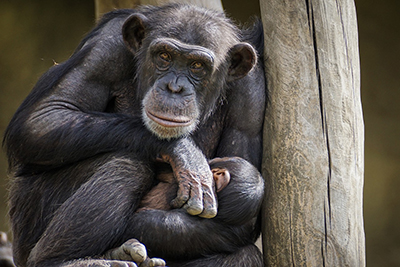
Bonobos and chimps diverged about 1.8 million years ago, after they were geographically separated by the Congo River and followed their own evolutionary routes. Although the bonobo centromeres are remarkably smaller than those of the chimp, they function fine.
More generally, analyzing segmental duplication allows scientists to determine which are lineage-specific to each ape species. Using the new resources, researchers are attempting to sort out, by location and composition, the segmental duplications that pertain to each species.
“We now have an evolutionary framework for understanding highly divergent, previously inaccessible regions of the ape genome,” the researchers wrote in their Nature paper. Such studies also uncover genomic constructions that are prone to reshuffling.
“Segmental duplication rearrangements may be a greater source than previously realized of interspecies differences and potential gene neofunctionalization,” the scientists noted.
Most evolutionary biologists believe that the differences that distinguish humans from chimpanzees are regulatory in origin — slight changes in where and when highly conserved genes are expressed. The ape genomes reference is providing a new model.
“We are discovering hundreds of protein-coding genes embedded in these segmental duplications that are unique to each ape species,” said Eichler. “Some of these have already been shown to contribute to changes that make us uniquely human, such as a bigger brain.”
The new results suggest that there are many more protein-encoding differences among the apes.
Acquiring more information on segmental duplication rearrangements may help researchers make headway in determining how certain conditions in humans, for example, developmental delay, intellectual impairments and autistic traits, stem from new mutations that might form in this manner.
While they believe that the ape genome samples are almost fully complete, the scientists said that there is still work to be done, including filling in a few of the last remaining complex gaps. Additionally, about 15 species and subspecies of apes remain to have their genomes sequenced and added to the reference resource.
The scientists say they also hope to eliminate biases in gene annotation that favor humans over the other ape species. Mapping genes onto genomic sequences and predicting the functional genes is challenging. Nonetheless, research has been impeded by ignoring potentially significant, but less studied, genes.
This development of the ape genome reference was supported, in part, by the Intramural Research Program of the National Human Genome Research Institute, National Institutes of Health, and extramural NIH grants 1161 R35GM151945, R01 HG002385, R01 HG010169, U24 HG007497, R35 1162 GM146926, R35 GM146886, R35GM142916, R01HG012416 1163, R35HG011332, R01GM123312, U24 HG010263, R35GM133747, U41HG007234, R01HG010329, R01MH120295, 1P20GM139769, R35GM133600 1166 , and 1U19 AG056169-01A1, UH3 AG064706, and U19 AG023122 as well as a Vallee Scholars Award. Financial support is also acknowledged from the Howard Hughes Medical Institute, Deutsche Forschungsgemeinschaft (German Research Foundation) (437857095, 1169 444810852), the Verne M. Willaman Endowment Professorship, the John and Donna Krenicki Endowment Professorship, the National Library of Medicine Training Program in Biomedical Informatics and Data Science (T15LM007093), National Institute of Allergy and Infectious Diseases (P01-AI152999 ), the National Recovery and Resilience Plan, the Italian Ministry of University and Research, funded by the European Union (CUP H53D23003260006, CUP H53D2300331) and Fondazione con il Sud (2018-PDR1188 01136).
For details about UW Medicine, please visit https://uwmedicine.org/about.
